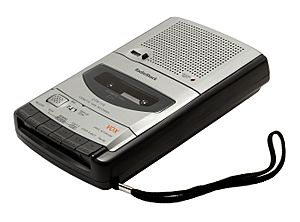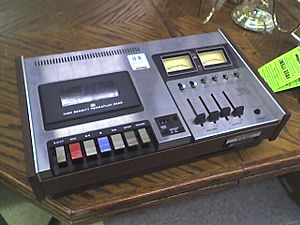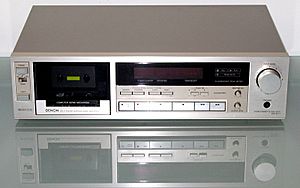Cassette player facts for kids
A cassette deck is a special machine that plays and records music or sounds onto compact cassettes. Think of it like an older version of a CD player or MP3 player, but for tapes! Cassette decks were often part of a home stereo system, while a "tape recorder" was usually a smaller, portable device. Even though the words "deck" and "recorder" were sometimes used for the same thing, a deck usually meant a high-quality home stereo part.
Contents
History of Cassette Decks
How Cassettes Started

Before cassette decks, people used reel-to-reel tape recorders. These machines used large tapes that had to be carefully threaded by hand. In 1958, the RCA company tried to make a simpler tape system with a cartridge, but it didn't become very popular.
Then, in 1963, the Philips company introduced the "compact cassette" at a big electronics show in Berlin. At first, these small tapes were only meant for recording voices, like for dictation or journalists. The sound quality wasn't great for music back then.
By the mid-1970s, cassette decks got much better at playing music. They started to become a common part of home stereo systems. Cassettes were easier to use than reel-to-reel tapes because they were smaller and you didn't have to thread the tape. This made them very popular for music, especially in cars and for portable players. Many people loved making their own custom mixtapes by recording songs from their vinyl records or other cassettes.
Most early cassette decks loaded the tape from the top and had simple "piano key" buttons. Later, in the late 1970s, front-loading decks became common. Some decks even had two cassette slots, so you could copy tapes easily.
Cassettes Become Very Popular
Cassette decks quickly became widely used everywhere. You could find them in professional studios, home stereo systems, and especially in cars. From the mid-1970s to the late 1990s, the cassette deck was the main way people listened to music in their cars. They worked well in moving vehicles and were much smaller than 8-track cartridges.
A huge reason for the cassette's success was the release of the Sony Walkman in 1979. This was a small, portable cassette player designed just for listening with headphones. Even though many other companies made similar players, the name "Walkman" became famous for all portable cassette players.
Almost every well-known audio brand made cassette decks, and many of them were very high quality.
Better Performance and Features
Cassette decks reached their best performance in the mid-1980s. High-end decks from companies like Nakamichi and Revox had advanced features. Some decks could even play both sides of the cassette without you having to flip it over. This was called "auto-reverse" and became very popular, especially in car stereos.
Thanks to improvements in electronics, tape materials, and how cassettes were made, the sound quality of top cassette decks became amazing by the late 1980s. They could play music with very clear highs and lows, and very little unwanted noise. Many people couldn't tell the difference between a high-quality cassette and a CD.
Prerecorded cassettes also got much better. Systems like XDR and better tape types meant that prerecorded cassettes sounded great. They were also more portable and easier to care for than vinyl records.
Cassettes in Cars
A big reason for the cassette's success was its use in car stereo systems. The small size of the cassette tape was much more convenient than the larger 8-track cartridges. Car cassette players were the first to have "auto-reverse," which meant the tape would automatically play the other side when it reached the end. Home cassette decks soon added this feature too.
You can even find Cassette tape adaptors today that let you play music from newer devices, like your phone, through an older car cassette deck. This is a clever way to use old technology with new!
Keeping Your Cassette Deck Working
Cassette decks need regular care because the tape touches parts inside the machine. If you don't clean them, the sound quality can get worse.
One common problem is that tiny bits of tape material can stick to the playback head. This means you need to clean the tape heads often. The metal parts and rubber rollers that move the tape can also get dirty, which makes the tape wobble and sound unclear.
Sometimes, the metal parts inside the deck can become magnetized. This can also affect the sound, so they need to be "degaussed" (demagnetized) sometimes.
You can use isopropyl alcohol to clean the tape heads and other parts. Just make sure it's pure alcohol and not "rubbing alcohol" that might have oil in it.
Why Cassettes Became Less Popular
When compact discs (CDs) and other digital recording technologies like DAT came out, many people thought cassette deck sales would quickly disappear. Philips even tried to make a "digital compact cassette" that could play old analog cassettes, but it didn't catch on.
However, CDs and cassettes actually lived side-by-side for almost 20 years! Early CD players had problems with scratches and skipping, especially in cars. Also, CD players were expensive at first and couldn't record music. Many home stereos had both a CD player and a cassette deck, so you could easily record CDs onto tapes.
The real decline of cassette decks happened with the rise of inexpensive digital music players, like those that played MP3s. By the late 2000s, very few new cars came with cassette decks.
Even though most people don't use them anymore, some still value cassette decks. Many people who are blind or elderly find cassettes easier to use than newer digital devices. Cassette tapes don't scratch easily, and they usually start playing right where you left off. You can also record on cassette tapes many times.
Today, most people don't think of cassette decks as the best way to record or play music because digital players offer much better sound quality for less money. However, cassettes are still used for some things, like recording meetings or audiobooks.
A cassette player (or cassette deck) is a device what can play audio cassettes. Some players also can record music or other sounds to cassette. If a microphone is built in, there is no need for a separate microphone but in that case the quality of sound may not be so good.
Images for kids









